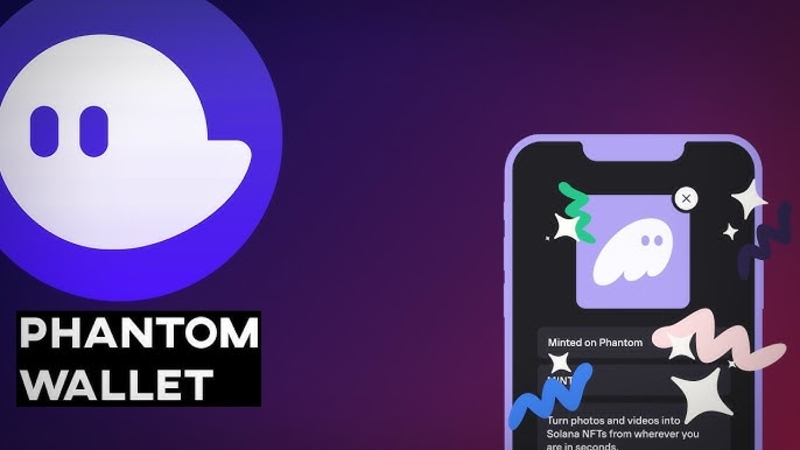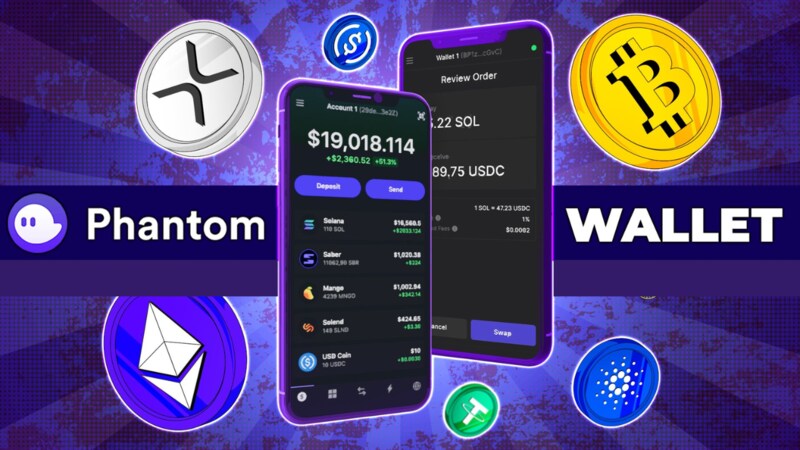Phantom Wallet is one of the most popular crypto wallets today, especially for Solana users. But can Phantom Wallet be hacked? Let’s explore this issue and discover ways to safeguard your assets!
What is Phantom Wallet?
Before diving into security concerns, let’s briefly introduce Phantom Wallet for those who are unfamiliar.
Phantom is a non-custodial cryptocurrency wallet designed specifically for the Solana blockchain. It allows users to store, send, and receive Solana (SOL) tokens and other SPL tokens. Phantom Wallet boasts a user-friendly interface, is easy to use, and can be accessed through a browser extension or mobile app.
How Phantom Wallet works and its security mechanisms
To better understand Phantom Wallet’s security capabilities, we need to delve into its operational mechanism. Like most non-custodial crypto wallets, Phantom operates on the principle of public-key cryptography, combined with additional security layers to protect user assets.
Public-Key Cryptography
Each Phantom wallet is created with a unique key pair:
- Private Key: This is the secret “key” that allows you to access and manage the assets in your wallet. The private key is randomly generated and known only to you. Never share this private key with anyone, including Phantom Wallet support.
- Public Key: This is your wallet address, similar to a bank account number. You can share this public key to receive cryptocurrency from others.
Phantom Wallet uses your private key to digitally sign transactions. This signature confirms that you are the legitimate owner of the cryptocurrency and allows the transaction to be executed on the blockchain.
Private key storage
Phantom is a non-custodial wallet, meaning you have complete control over your private key. The private key is encrypted and stored locally on your web browser. This gives you maximum control over your assets, but it also places the responsibility for security on your shoulders.
Additional security Layers
In addition to public key cryptography, this wallet also integrates additional layers of security to enhance user protection:
- Password: You need to create a strong password to protect your wallet. This password is used to encrypt your private key and prevent unauthorized access.
- Seed Phrase: When creating a wallet, you will receive a 12 or 24-word seed phrase. This phrase is used to recover your wallet in case you forget your password or lose your device. Store this seed phrase in a safe and secret location, preferably offline.
- Two-Factor Authentication (2FA): You can enable 2FA to enhance wallet security. 2FA requires you to enter a verification code from your phone or authenticator app each time you log in or make a transaction.
Advanced security features
Phantom Wallet also offers several advanced security features to help users detect and prevent threats:
- Fake Website Warnings: It will warn you if you are trying to connect to a fake website.
- Application Access Control: It allows you to control the access of DeFi applications to your wallet.
- Access Revocation Function: You can revoke the access of DeFi applications to your wallet at any time.
Can Phantom Wallet be hacked?
The answer is YES. Although Phantom Wallet has certain security measures in place, no cryptocurrency wallet is completely secure. Phantom Wallet can be hacked if:
- The wallet itself has unpatched security vulnerabilities.
- Users do not adhere to security principles, making mistakes such as using weak passwords, storing seed phrases insecurely, connecting to fake websites, or granting permissions to malicious applications.
Reasons why Phantom Wallet can be hacked
Security vulnerabilities from Phantom Wallet
Although Phantom Wallet is developed by an experienced team, no software is perfect. In the past, there have been some reports of security vulnerabilities on Phantom Wallet, such as:
- August 2022: Thousands of Solana wallets, including Phantom Wallet, were attacked, resulting in millions of dollars in losses. The cause was identified as a vulnerability in the private key generation mechanism of some mobile wallets.
- January 2023: Phantom experienced an issue displaying incorrect account balances, however this issue did not affect user assets.
Whenever a vulnerability is discovered, the Phantom Wallet development team quickly releases patches and updates to fix it. However, this shows that this type of wallet can still be attacked if there are security vulnerabilities that have not been discovered or fixed.
Risks from users
In reality, most cryptocurrency wallet attacks stem from user error, not wallet vulnerabilities. Some common mistakes include:
- Using weak, easily guessed passwords: Weak passwords are easily guessed by hackers or brute-force attacked.
- Insecure storage of seed phrases: The seed phrase is the key to accessing your wallet. If exposed, anyone can steal your assets. Do not store your seed phrase on your computer, phone, or any device connected to the internet.
- Connecting your wallet to fake (phishing) websites: Hackers can create fake Phantom Wallet websites to trick users into entering their private keys or seed phrases.
- Granting permissions to malicious applications: Some malicious applications may request access to your wallet and steal assets.
Cyberattacks
Hackers are always looking for ways to exploit security vulnerabilities to attack cryptocurrency wallets. Some common forms of attack include:
- Phishing: Tricking users into providing sensitive information such as private keys or seed phrases.
- Malware: Malicious software installed on the user’s device to steal information or control the wallet.
- Social engineering: Exploiting user psychology to trick them into providing information or performing actions that benefit the hacker.
How to protect your Phantom Wallet
Here are some important security measures you need to take to protect your assets on Phantom Wallet:
Secure your private key
- Use a strong password and change it periodically. Passwords should include uppercase, lowercase, numbers, and special characters.
- Carefully store your seed phrase. It is best to write it down on paper and keep it in a safe place, or use a hardware wallet.
- Never share your private key or seed phrase with anyone.
Beware of fake websites
- Only visit the official Phantom Wallet website: phantom.app
- Carefully check the URL before connecting your wallet.
- Do not click on suspicious links in emails or messages.
Increase security awareness
- Learn about common cyberattack methods.
- Regularly update your knowledge of cryptocurrency security.
- Join reputable communities to exchange information and experiences.
Use advanced security features
- Enable two-factor authentication (2FA): 2FA provides an extra layer of security by requiring you to enter a verification code from your phone or authenticator app.
- Use a hardware wallet to store large amounts of assets: Hardware wallets like Ledger or Trezor store your private keys offline, protecting your assets from cyberattacks.
How to use Phantom Wallet
Install Phantom Wallet
Phantom Wallet is currently available as an extension for Chrome, Firefox, Edge, and Brave browsers.
- Visit the official Phantom Wallet website: phantom.app
- Select your browser and click “Download”.
- Add the extension to your browser.
Create a new wallet
- Open the Phantom Wallet extension.
- Click “Create New Wallet”.
- Save your seed phrase in a safe place. This is the only key to recover your wallet if you forget your password or lose your device. Write it down and keep it carefully, or use a hardware wallet.
- Set a strong password for your wallet.
- Confirm the password.
Phantom Wallet interface
After creating your wallet, you will see the main interface of Phantom Wallet.
- Overview Tab: Displays your account balance, transaction history, and portfolio.
- Token Tab: Manage the tokens you hold. You can send, receive, swap, or add new tokens.
- NFT Tab: View and manage your NFTs (Non-Fungible Tokens).
- DeFi Tab: Access DeFi applications integrated with Phantom Wallet.
Receive tokens
- Open the Overview tab.
- Click “Receive”.
- Copy your wallet address or scan the QR code.
- Share this wallet address with the sender.
Send tokens
- Open the Token tab.
- Select the token you want to send.
- Enter the recipient’s wallet address.
- Enter the amount of tokens you want to send.
- Click “Send” and confirm the transaction.
Swap tokens
- Open the Token tab.
- Select the token you want to swap.
- Click “Swap”.
- Select the token you want to receive.
- Enter the amount of tokens you want to swap.
- Click “Swap” and confirm the transaction.
Connect to DeFi applications
- Open the DeFi tab.
- Select the DeFi application you want to use.
- For example, to use Raydium, a decentralized exchange (DEX) on Solana, you would select Raydium from the list.
- Phantom Wallet will automatically connect to the application.
Other features
- Staking: Phantom Wallet allows you to stake SOL and other tokens to earn rewards.
- Manage multiple wallets: You can create and manage multiple wallets on Phantom Wallet.
- Settings: Customize wallet settings, including language, currency units, display theme, and security.
Notes on use
- Always update wallet to the latest version.
- Beware of fake websites. Only visit the official Phantom Wallet website.
- Do not share your private key or seed phrase with anyone.
- Use a strong password and enable two-factor authentication (2FA).
- Consider using a hardware wallet to store large amounts of assets.
Phantom Wallet is a useful tool for Solana users, but security remains a key factor. By applying the necessary security measures, you can minimize the risk of being attacked and effectively protect your assets. Be a wise user and proactively protect your assets in the volatile world of cryptocurrency.
If you have any further questions about safety and protecting your digital assets, please leave a comment below and Blockchain Global Network will help you answer them soon!





RELATED POSTS
What is ETH Analysis? Trends, Predictions, and What’s Next for Ethereum
Ever wondered what makes Ethereum...
Bitcoin Unveiled: A Peer to Peer Electronic Cash System
Discover the Genesis of Bitcoin:...
Blockchain Ballots: Revolutionizing Voter Fraud Prevention Systems
Examples of blockchain-based voter fraud...
What is a 51% attack? How a Blockchain Takeover Threatens Your Crypto
What is a 51% attack?...
Blockchain Breakthrough: Sources of funding for blockchain research
Sources of funding for blockchain...
NebulaStride Airdrop – Tips to Maximize Income
To maximize your income from...
Blockchain Simplified: Unlocking the Secrets Behind Digital Ledgers
"Demystifying Blockchain: An Introductory Guide...
How does Robinhood work? The Gateway to Blockchain
In today’s rapidly evolving financial...
Security Challenges in DeFi: Navigating the Uncharted Waters Safely
Protect Your DeFi Applications from...
How does blockchain improve security: Enhancing Security in a Digital Age
How does blockchain improve security?...
A Slice of History – The First Recorded Bitcoin Purchase and Its Impact Today
The First Recorded Bitcoin Purchase...
How Blockchain Boosts Educational Equity: A Tech Revolution in Learning
How can blockchain promote educational...
Variational Airdrop: VAR Token hunting guide
Variational is a Peer-to-Peer (P2P)...
ICMP Protocol: Important protocol in network management
The ICMP Protocol (Internet Control...
Blockchain Security Audits: Essential Shields Against Cyber Threats
Understanding the Importance of Blockchain...
Mining Cryptocurrency how to? How to read trading charts cryptocurrency?
When venturing into the world...